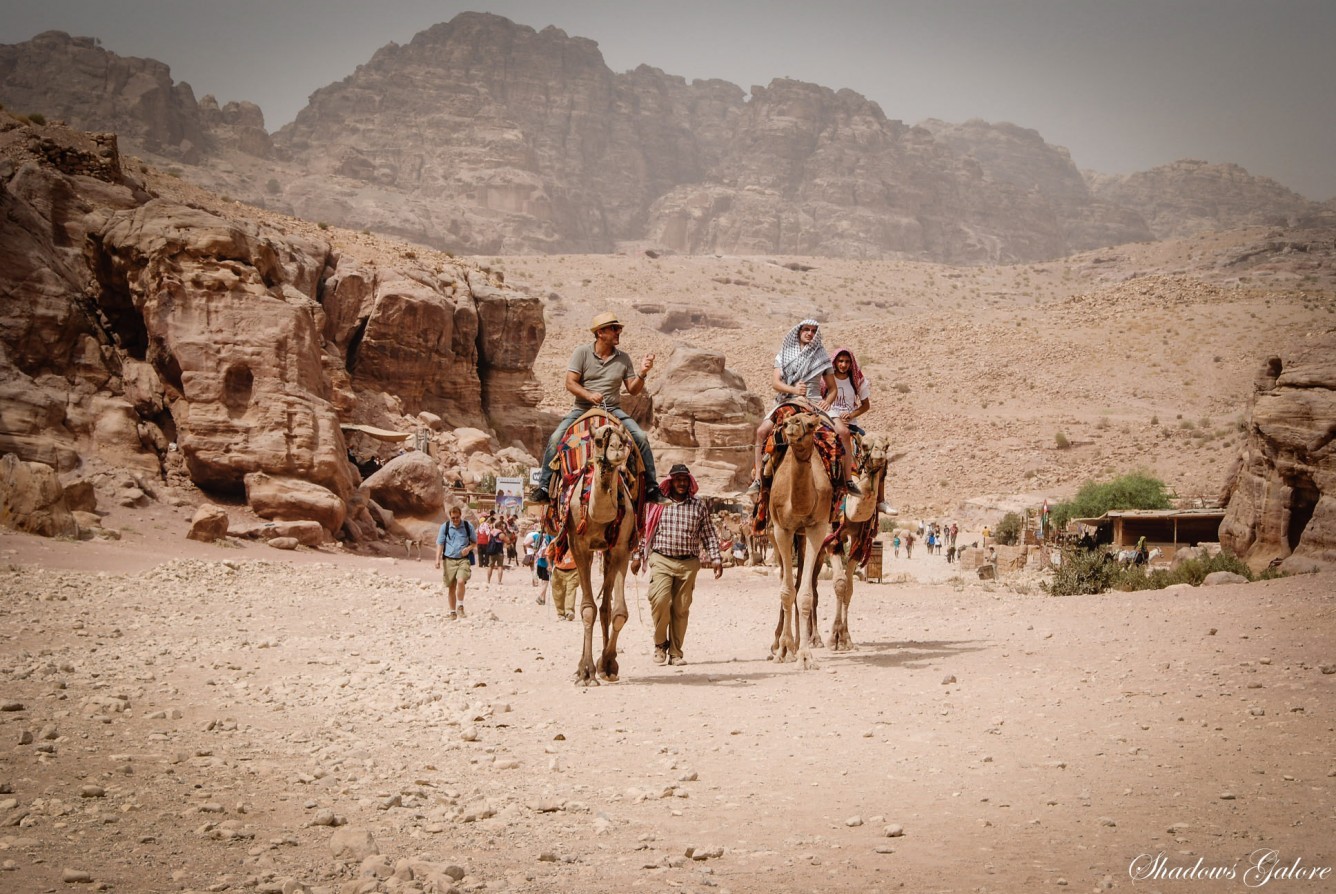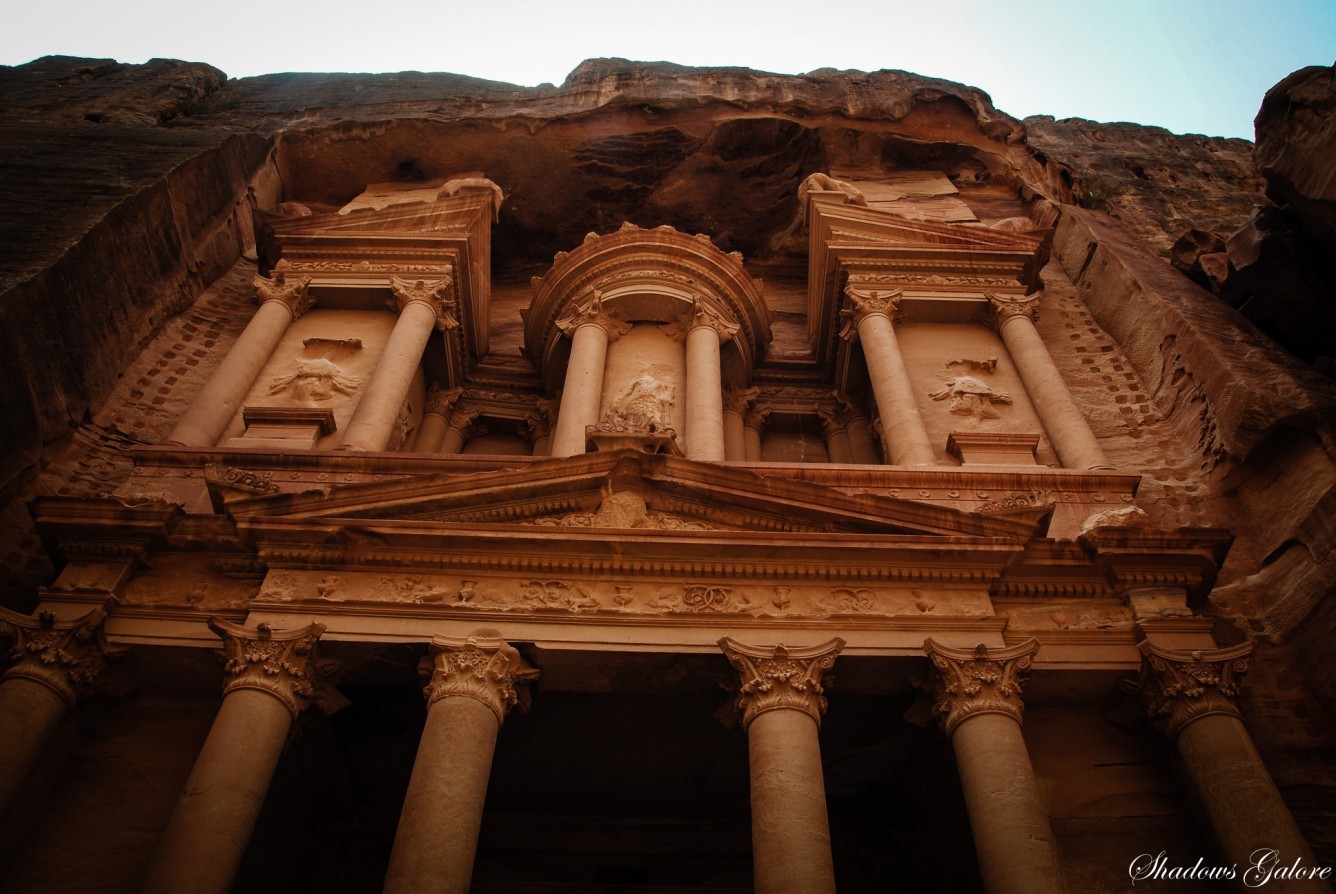
The ancient city of Petra stands as a mute witness to an incredible civilization that blossomed nearly 2000 years ago in this remote desert surrounded by rocky cliffs, flourished for millennia and then just faded away, brushed under the carpets of time. It has long been on our bucket-list and was my foremost aspiration when we set out for Jordan.
The previous day had been spent exploring the historical Jordan in Amman and the Northern areas, but the big day of our journey was today. Today we would visit Petra, the most iconic destination of Jordan and one of the most coveted among the travelers of the world! No wonder everyone was ready early in the morning and by 8 AM we were done with our breakfast and ready to go.
Petra is located about 250 KM to the south of Amman and the running time is about 3 and a half hours. We took the desert highway and by 12 noon were at Movenpick, located just outside the gates of Petra.
The Siq
After getting our tickets, the long awaited travel on the Petra trail started. As one enters the gates of the archeological site, there appears a long road leading to the Siq (“the shaft”), a dark narrow gorge only 3-4 m wide at places. There were colorful horse carriages which carry tourists on this trail as motorized vehicles are not used (thankfully!), but it is best to walk if one wants to enjoy every moment inside this Wonder of the World.
On the way, lies Bab Al Siq (“Gate of the Siq”), ‘a lunar landscape’ of rocky domes and looming cliffs dotted with caverns, which turn different shades of brown and beige during different hours of the day. There are many facades or tombs similar to caves craved out of rocky faces along the path. One can notice a staircase like structure above these facades which signify the loved ones path to heaven after death.
Further ahead is a dam, originally built by the Nabateans on the bed of Wadi Musa in about 50 AD and rebuilt recently. There is a small shop besides the dam where one can buy some refreshments. There are not many shops inside the site where water can be bought and it is better to stock up some water at this point.
Then starts the beautiful Siq, famous for its dramatic topography, and a journey through it is a revelation in itself. After about 1 KM into the Siq, one comes across beautifully patterned rocks, each layer giving a glimpse of an era which passed long before mankind came into existence. The anticipation that builds up as you walk through the walkway of what lies beyond is killing. Siq throws a strange dilemma in a visitor’s mind, while one cannot wait to go past it to see the treasury, its captivating beauty makes one wish that time just stood still.
The Story of Petra
Petra (Arabic: البترا, Ancient Greek: Πέτρα) traces its first human activity to as early as 7000 BC; it finds references in ancient Egyptian accounts and the Book of Exodus and it was to the north of the city that Moses is said to have struck a rock from which water burst forth.
The city of Petra, as we know it now, was founded by the Nabataeans around 300 BC and flourished as a major centre in the trade route to Palestine. There are hardly any written records of this civilization, rarely any inscription has been found on the walls and libraries are conspicuous by their absence. However, the Nabataeans left their mark in the form of a magnificent city, protected by natural barriers and fed by an intricate network of networks of water capture, storage, transport, and irrigation systems. The trade filled their coffers, enabling lavish construction, and by 200 BC, the city was at its zenith – probably one of the wealthiest cities in the world, and such a magnificent urbane city in stone that would cause modern architects to gape in wonder.
Romans conquered Petra in 106 AD and by 423 AD it had been converted to Christianity which would remain the primary religion till the arrival of the Arabs. It is difficult to say what caused the demise of the city by the most probably theories point to a decline in trade combined with earthquakes and a collapse of water management system. The fading city continued to linger on till the Byzantine era before it disappeared from the conscious of the world. When British archaeologist Agnes Conway arrived in the city in 1812 AD, it was mostly deserted but for a handful of Bedouin who were still living here.
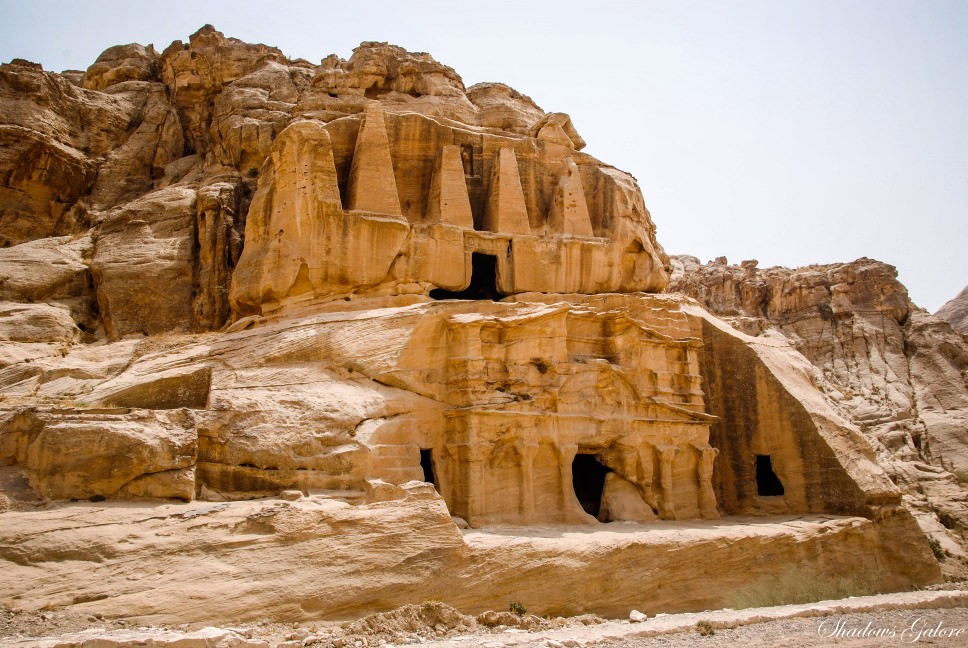
Bab Al Siq
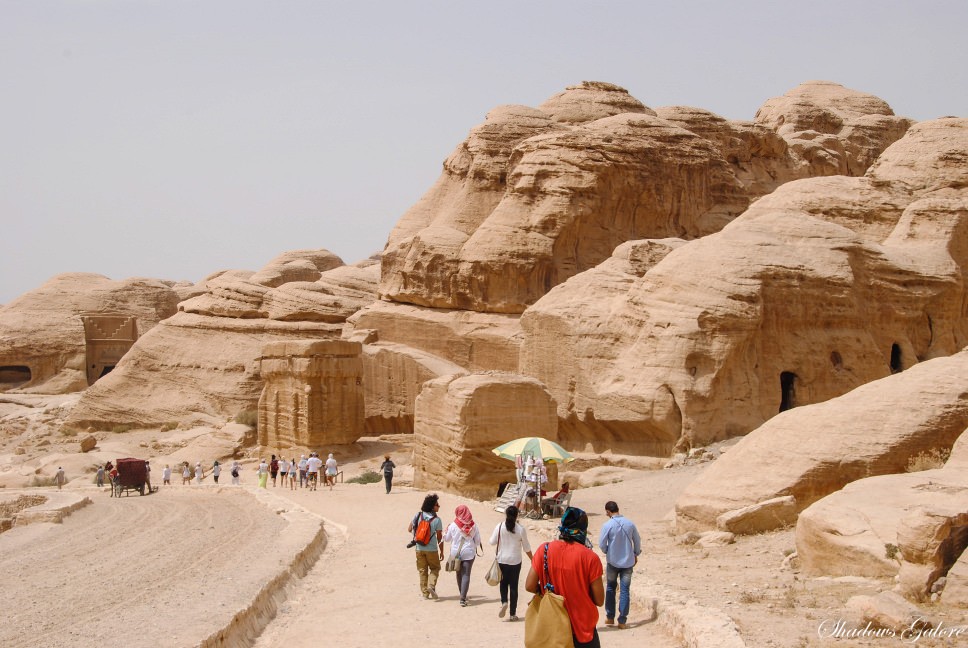
First View of Petra!
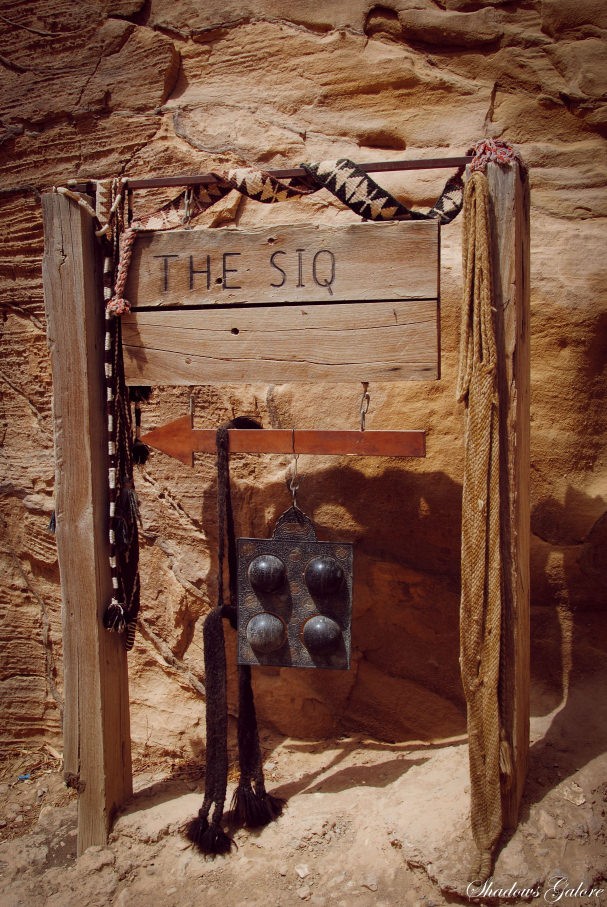
Entrance to the Siq..
One of the fascinating aspects of this journey is to hear the sounds of the horse carriages at a distance and then wait for it to just appear from the rocks. The site of the colorful carriage racing between the grey rocks is amazing.
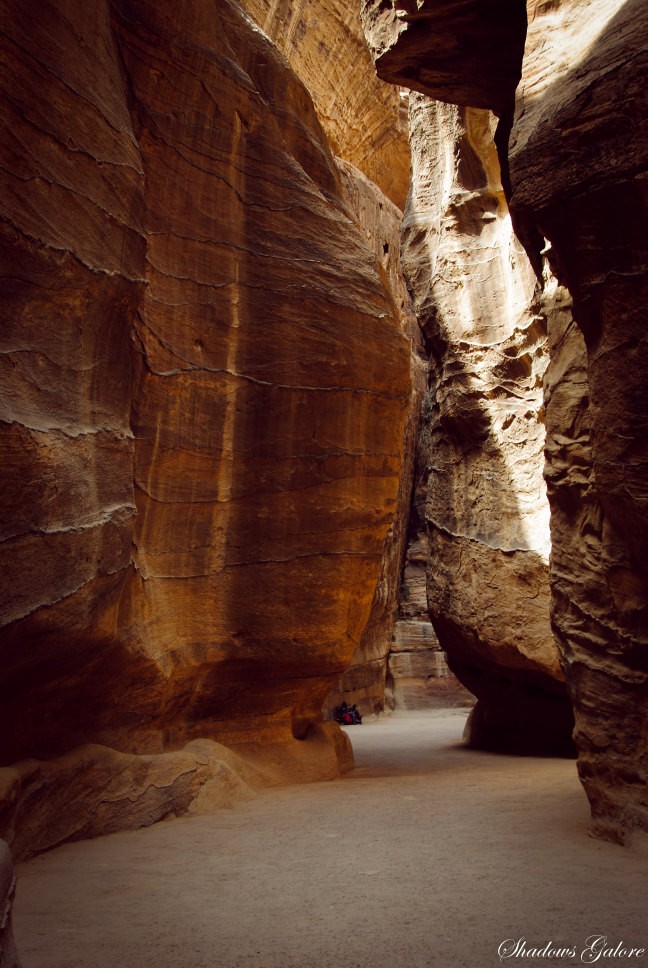
Colourful rocks of the Siq
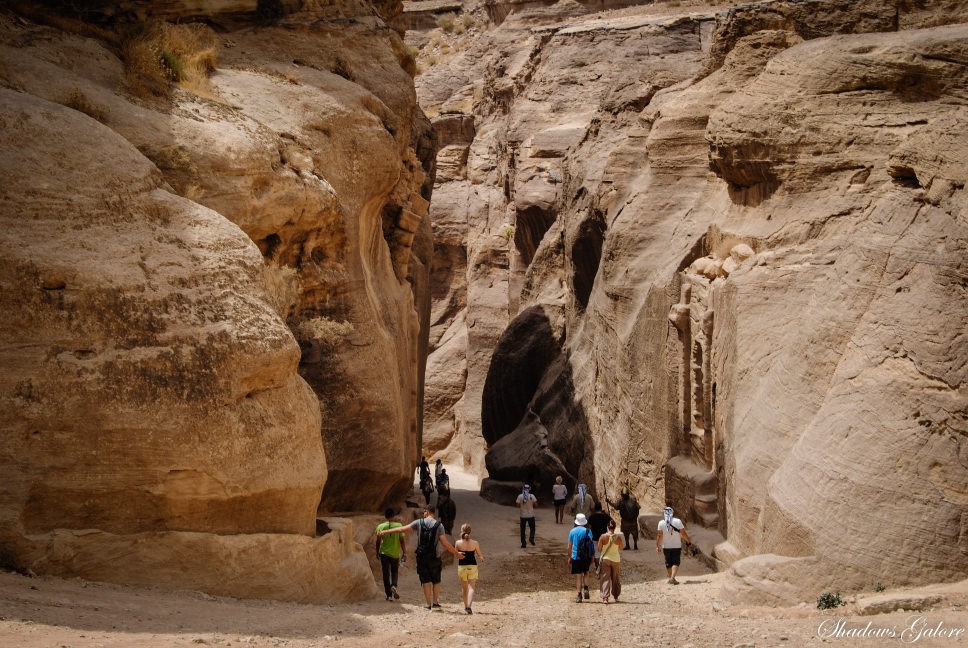
Guards standing to protect Petra
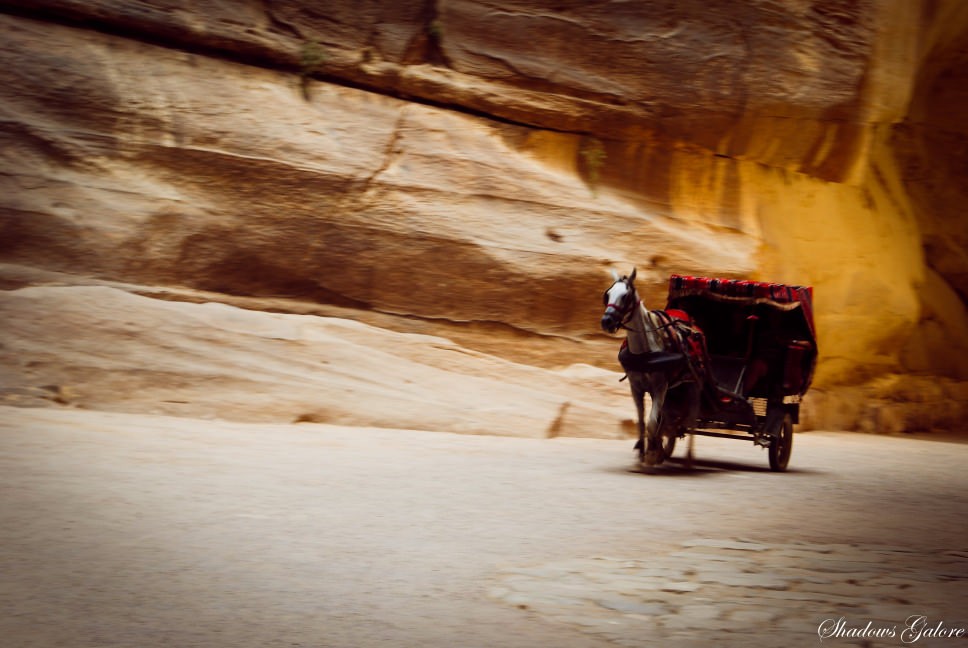
Horse Carriages to commute the tourists
The Treasury
The moment when the twisting and turning Siq slowly reveals the sunlit facade of ‘Al Khazana’ or the Treasury is one when you realize that a dream has come true. The rose color building towers between the rocky hillsides, presenting a spectacle that is unexpected and awe-inspiring in a surreal way.
The Treasury is the most iconic monument and the face of Petra to the world. Carved out of a cliff face centuries ago, its structures carry influence of pre-Islamic Middle-Eastern, Roman and Egyptian cultures. It was most probably just a royal tomb however the richness of its architecture could only have come if it held treasures. The giant urn above the entrance still bears bullets marks of treasure thieves who tried to smash it to retrieve the gold they believed it was hiding.
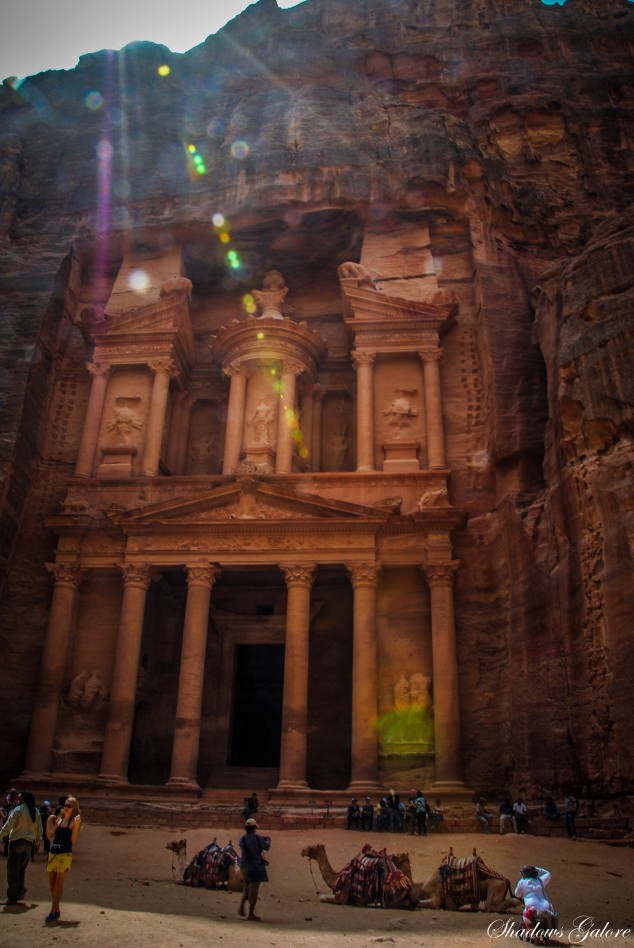
The Treasury sparkling under the sun
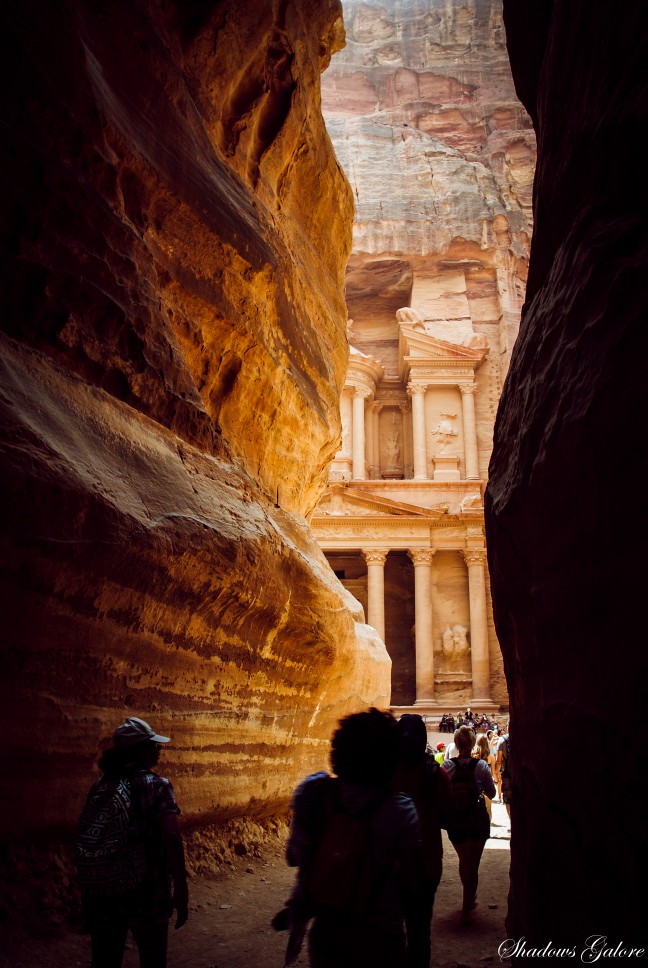
First peak from the Siq!
As we walked past, we came across the Bedouin, local nomads who are allowed to stay and work in Petra. Here we met ‘Lost’ (goes by the name ‘Lost in Petra’ in Facebook) who looked a lot like Johnny Depp – long curly hair, kohl laden eyes, and a mischievous smile. He was a funny chap trying to get customers for his mule and casually flirting with ladies (asking ‘how many camels for you’ is a common way of complimenting a female though it may sound pretty rude to the uninitiated).
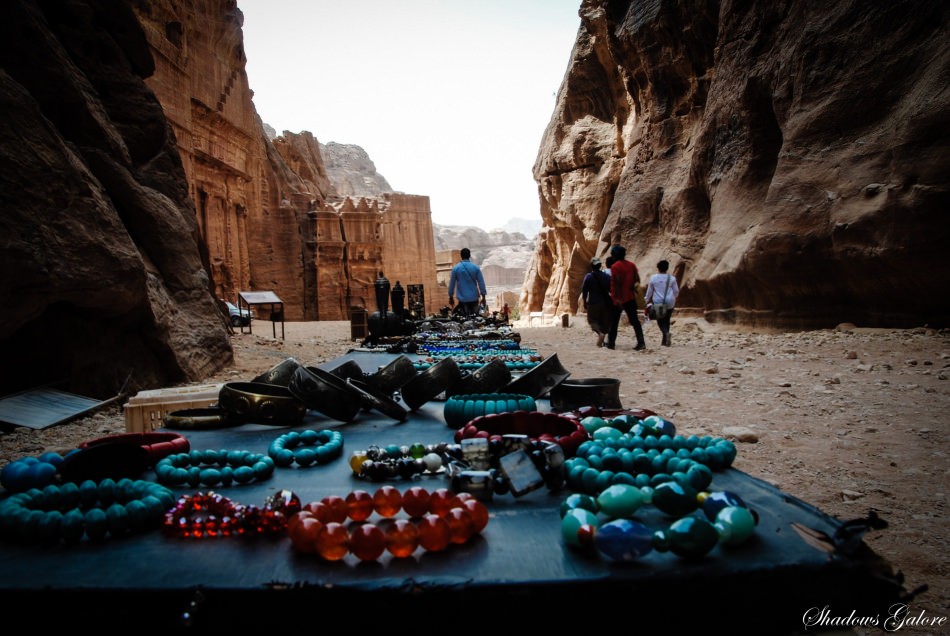
Street of Facades

Bedouin men are friendly
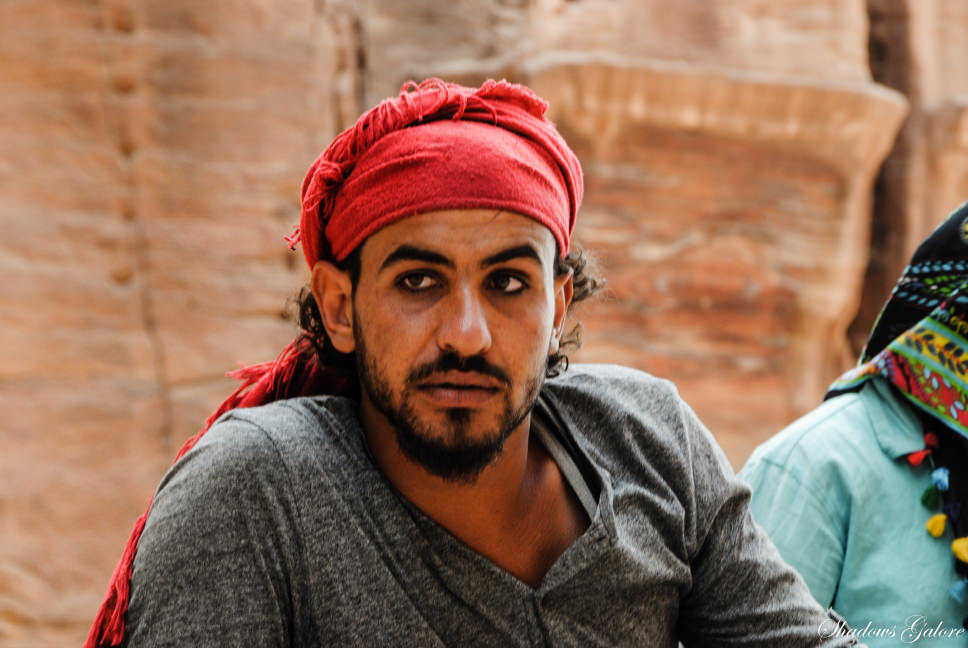
'Lost' in Petra
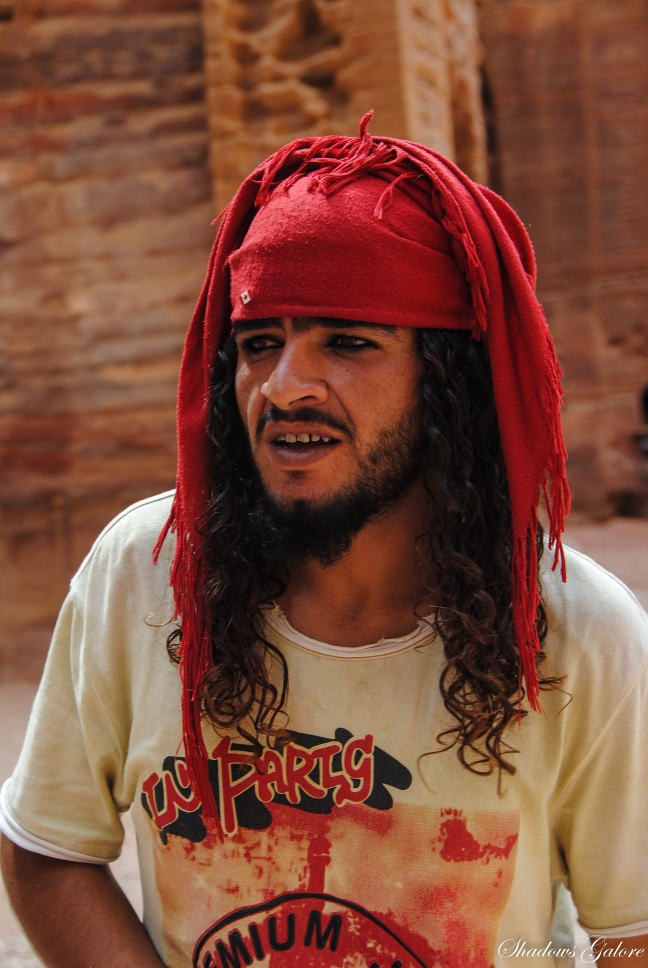
'Moon' who works in Petra
The Theatre
Further ahead is the Theatre, carved out of the mountain and in a distinct Hellenistic style with the seating rows coming straight up to the ground level. In its heydays, this massive theater could have accommodated up to 8500 spectators. The back rows were built over a cluster of older tombs which were removed to make way entertainment. Standing there, I wondered how would it have looked 1900 years ago, colorful and alive with crowds of excited townsfolk cheering performers in the grounds.
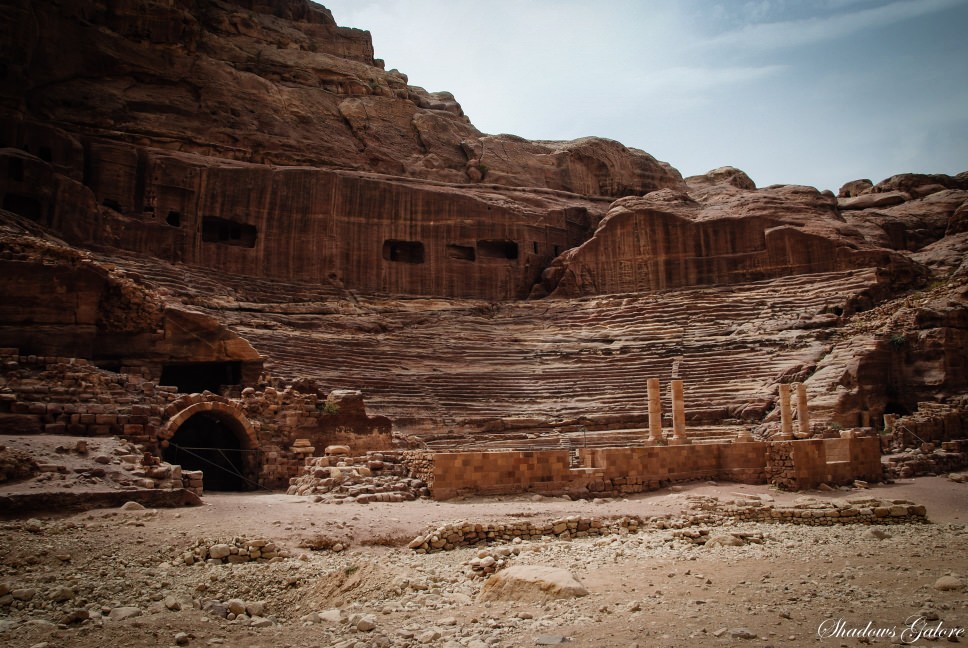
The Theatre
Royal Tombs
The path along the Theater has many cafés and stalls on both sides of the road. The sun was pretty harsh so we decided to get inside one of them – The Basin, that servers a large spread buffet lunch. While going there, we noticed the Royal Tombs up on the hill. Though I did not go there, this place provided for a good vantage point to take photographs of the panorama.
These are beautifully carved tombs were the members of the royal families were buried. The first is the Urn Tomb. Historians are split whether this is the tomb of Nabataean King Malchus II who died in 70 AD or the tomb of Aretas IV. Next is the rose colored silk tomb. Besides that is the Corinthian Tomb which gets its name due to the elaborate and ornate carvings. The last tomb in the row is the Palace Tomb. As the name suggests, the tomb is quiet big. The lower part consists of 12 decorated columns and four gates and 18 pillars above the threshold.
Just opposite the tombs is the Colonaded Street built by the Nabateans. It was later rebuilt by the Romans. The street was the main market area of ancient Petra, with stored buildings on each side.
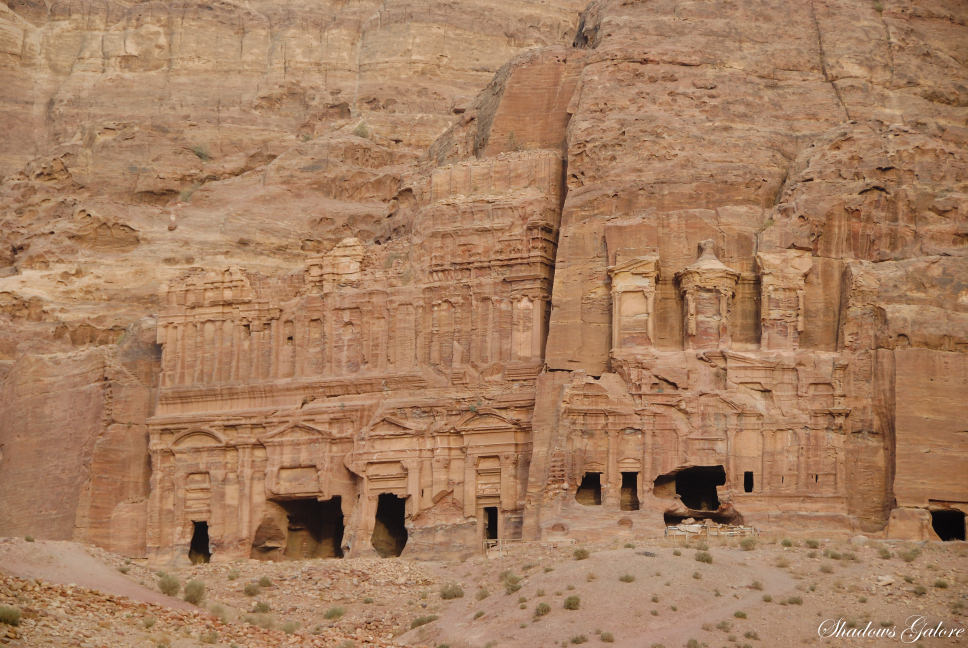
Corinthian Tomb
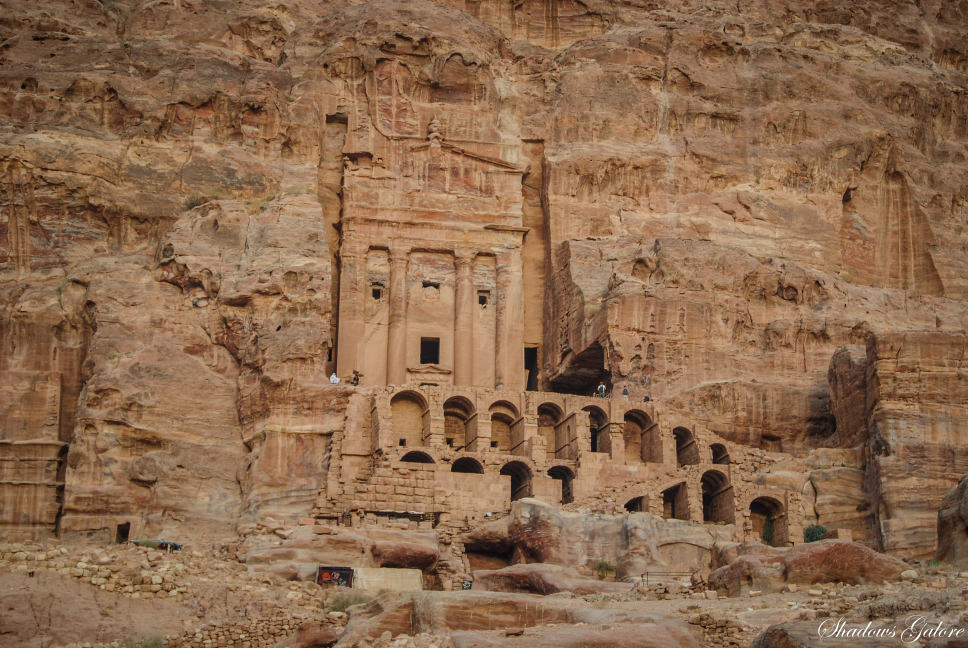
Urn Tomb
Exploring Petra
After lunch we decided to split up. Fatigue was fast catching up, so Anu and I decided to hire mules to the monastery which came up to $7.00 after some haggling. We started the upward journey and passed the rocky mountain-side. The Mules have this weird habit of walking along the very edge of the cliffs and looking down is not recommended for the faint hearted. Though the accent is quite steep and there are about 1400 steps, the steps are small and one can climb this path with ease. There were small Bedouin tents along the path, selling jewelry, scarves and other souvenirs.
Halfway through the accent, the Bedouin kid accompanying us decided to go no further, arguing this was thus far the mules could go. Taking a break from the exploration, we sat in a tent and listened to some fantastic folk music in a perfect setup in the mountains.
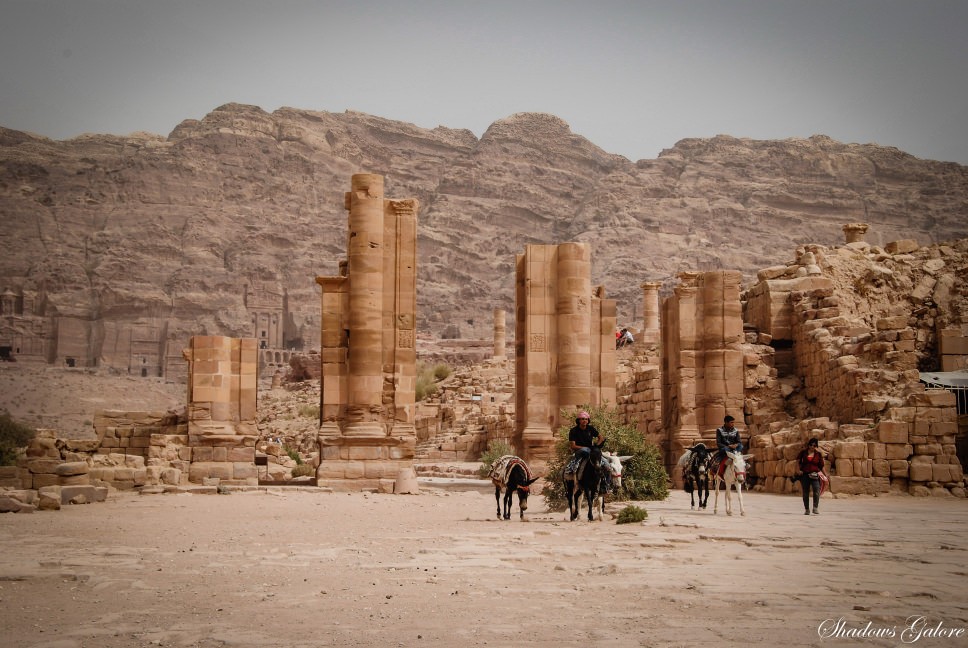
Gate on the Colonnaded Street
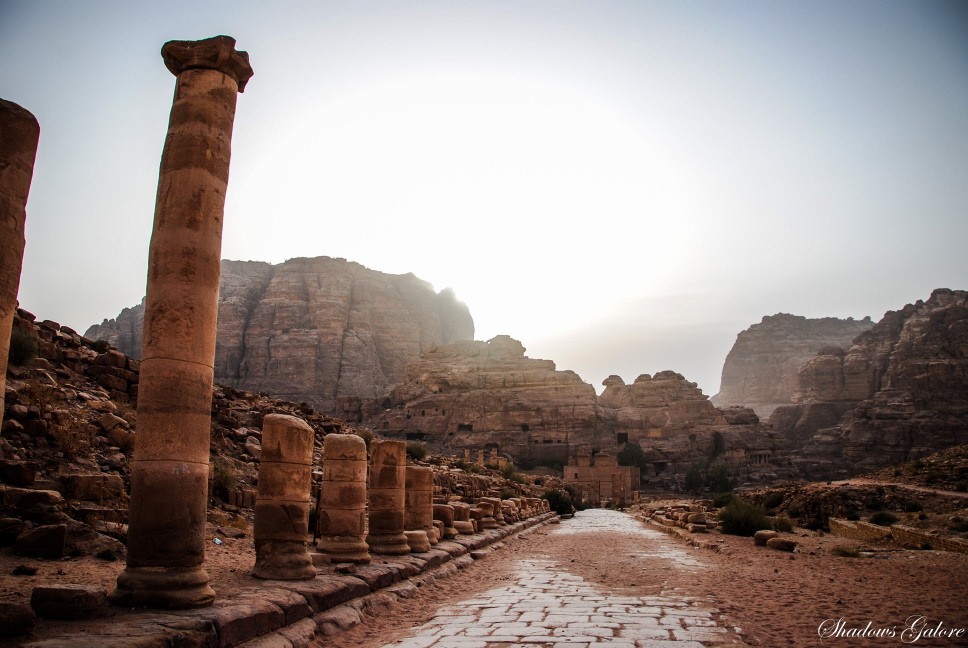
Colonnaded Street
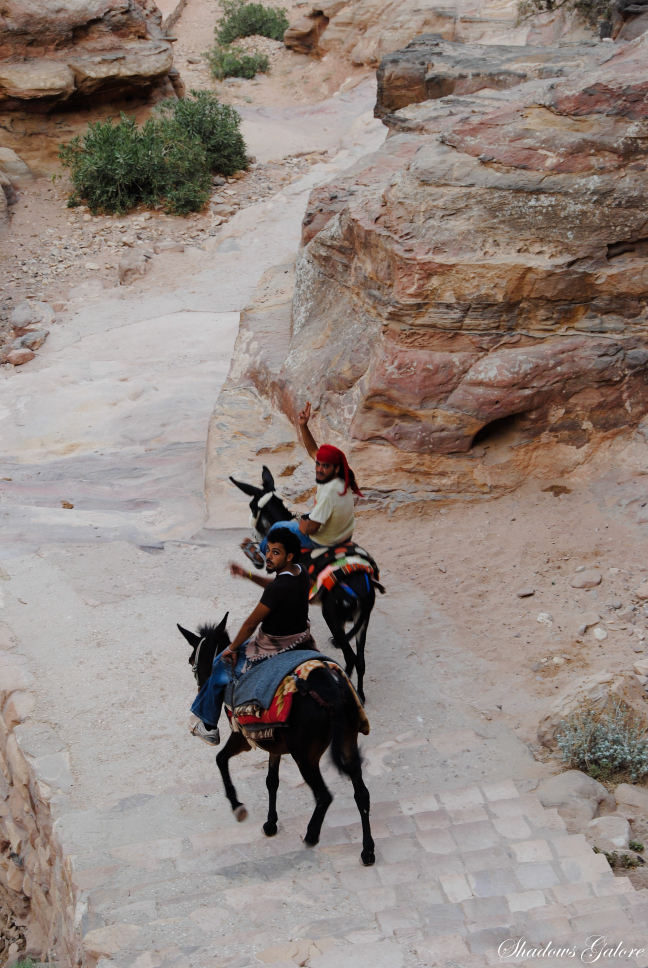
Hike to the Monastery
The Monastery
The monastery was another 15-20 minutes’ walk away and we were glad to finally have made it. It looks very similar to the treasury and yet, is quite unlike the former in its size and isolation. Beautifully carved, but not as much as the Treasury, this huge structure was probably a temple dedicated to the Nabatean king Obodas I (96-85 BC) and could have been used as a hermitage or a church later on. It has a façade which is rather plain on the lower levels, but gets increasingly intricate as the height increases. The central columns support a central urn which itself is about 10 m high, bringing the height of the structure to about 50m.
As we walked around taking photographs, we noticed something very peculiar. One of the Bedouins (named Moon this time) had climbed all the way to the top of the monastery and was jumping here and there in a crazy attempt to show off his ‘skills’. When he finally decided to come down, we got a chance to talk to him. He lived in one of the caves within Petra and worked here as well. His dream is to ‘stay happy and enjoy with friends and family’. Amen to that!
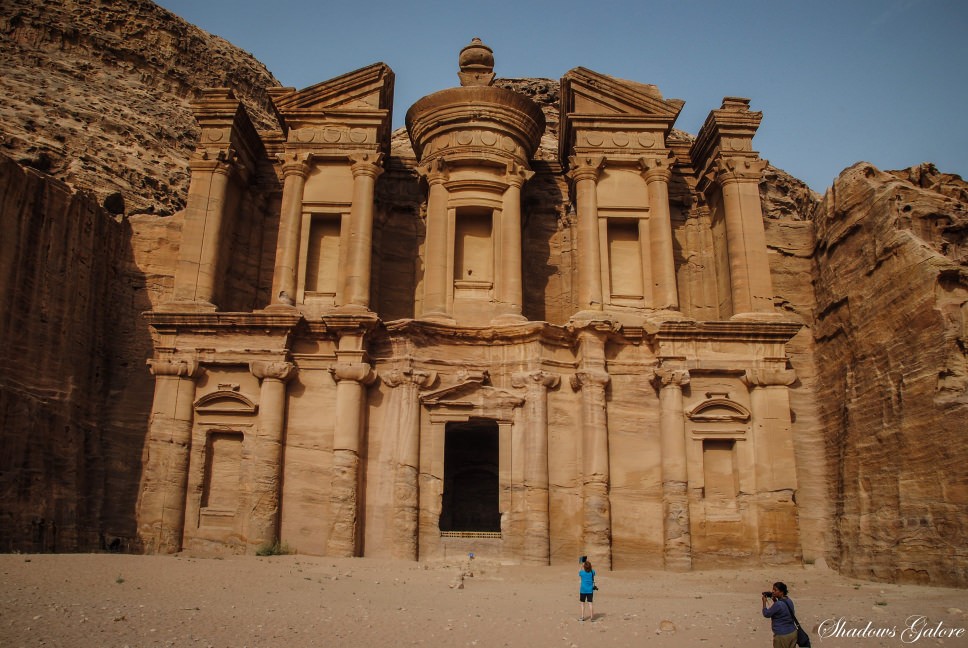
The Monastery
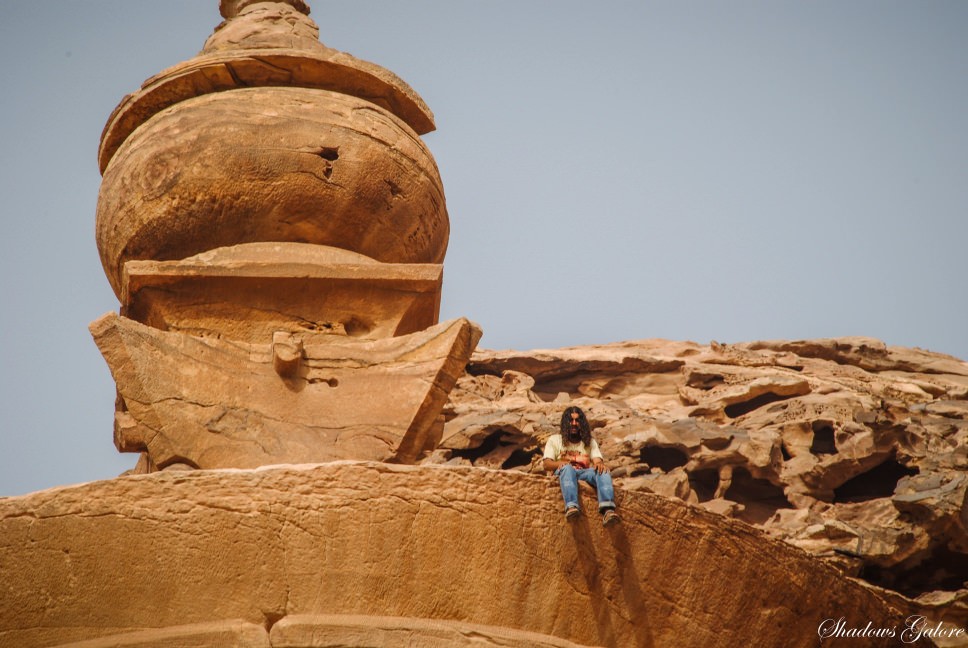
Moon showing off his stunts and helps put the enormity of the monument in persepctive
As it was getting late, we started walking back. The stroll back down was pleasant, and we walked in leisure stopping and taking photographs wherever we wanted. Though the Bedouins are usually quite friendly, refusing their mule rides may irk them and their jovial comments may turn into taunts. It is better to pay no heed to that and continue to do what you want to (as anywhere else in life). Moon tried to pester in renting his mule but we persisted and later he let us go.
The walk back was uneventful, we just walked in peace taking in the scene without tourists and wondering how beautiful Petra is. We decided to give a slip to the Royal tombs and went directly towards the Siq instead. Though the journey back may seem short, it is still recommended that you take the carriage back through the Siq to the main gate.
I was so glad that our hotel was just opposite the gate. By the time we reached, it was around 8 PM. The original plan was to go for a cooking lesson in Jordanian Cuisine at the famous Petra kitchen but I was too tired to make it. A few others, did manage to go there and cooked us a wonderful supper. They got a hands-on experience on cooking the national dish Mansaf – a traditional dish made of lamb cooked in a sauce of fermented dried yogurt. The spread was princely by any standards and tasted amazing. I slept a happy person that night, dreaming of the red rose city, that was half as old as time …

